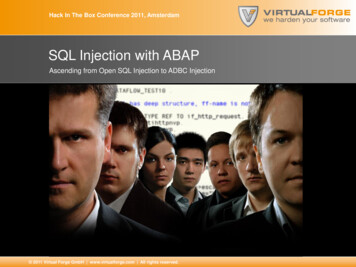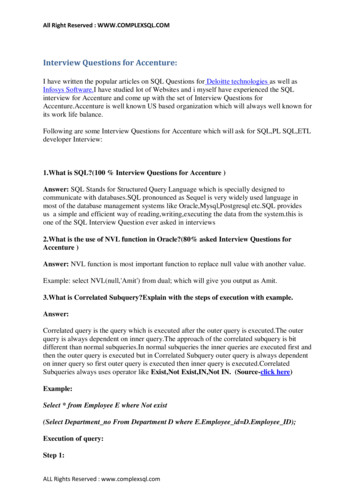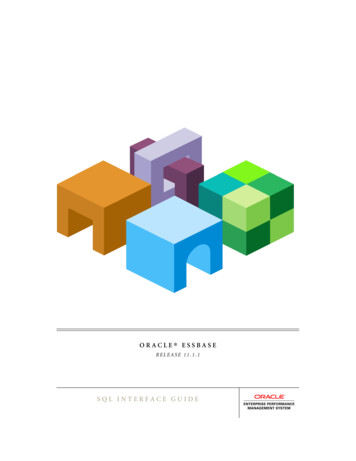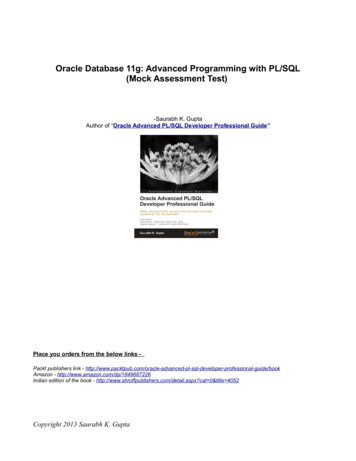
Transcription
Extracted from:SQL AntipatternsAvoiding the Pitfalls of Database ProgrammingThis PDF file contains pages extracted from SQL Antipatterns, published by thePragmatic Bookshelf. For more information or to purchase a paperback or PDFcopy, please visit http://www.pragprog.com.Note: This extract contains some colored text (particularly in code listing). Thisis available only in online versions of the books. The printed versions are blackand white. Pagination might vary between the online and printer versions; thecontent is otherwise identical.Copyright 2010 The Pragmatic Programmers, LLC.All rights reserved.No part of this publication may be reproduced, stored in a retrieval system, or transmitted,in any form, or by any means, electronic, mechanical, photocopying, recording, or otherwise,without the prior consent of the publisher.The Pragmatic BookshelfDallas, Texas Raleigh, North Carolina
SQL AntipatternsAvoiding the Pitfalls of Database ProgrammingBill KarwinThe Pragmatic BookshelfDallas, Texas Raleigh, North Carolina
Many of the designations used by manufacturers and sellers to distinguish their productsare claimed as trademarks. Where those designations appear in this book, and The PragmaticProgrammers, LLC was aware of a trademark claim, the designations have been printed ininitial capital letters or in all capitals. The Pragmatic Starter Kit, The Pragmatic Programmer,Pragmatic Programming, Pragmatic Bookshelf, PragProg and the linking g device are trademarks of The Pragmatic Programmers, LLC.Every precaution was taken in the preparation of this book. However, the publisher assumesno responsibility for errors or omissions, or for damages that may result from the use ofinformation (including program listings) contained herein.Our Pragmatic courses, workshops, and other products can help you and your team createbetter software and have more fun. For more information, as well as the latest Pragmatictitles, please visit us at http://pragprog.com.Copyright 2010 Bill Karwin.All rights reserved.No part of this publication may be reproduced, stored in a retrieval system, ortransmitted, in any form, or by any means, electronic, mechanical, photocopying,recording, or otherwise, without the prior consent of the publisher.Printed in the United States of America.ISBN-13: 978-1-934356-55-5Encoded using the finest acid-free high-entropy binary digits.Book version: P3.0—March 2012
An expert is a person who has made all themistakes that can be made in a very narrowfield. Niels BohrCHAPTER 1IntroductionI turned down my first SQL job.Shortly after I finished my college degree in computer and information scienceat the University of California, I was approached by a manager who workedat the university and knew me through campus activities. He had his ownsoftware startup company on the side that was developing a database management system portable between various UNIX platforms using shell scriptsand related tools such as awk (at this time, modern dynamic languages likeRuby, Python, PHP, and even Perl weren’t popular yet). The manager approached me because he needed a programmer to write the code to recognizeand execute a limited version of the SQL language.He said, “I don’t need to support the full language—that would be too muchwork. I need only one SQL statement: SELECT.”I hadn’t been taught SQL in school. Databases weren’t as ubiquitous as theyare today, and open source brands like MySQL and PostgreSQL didn’t existyet. But I had developed complete applications in shell, and I knew somethingabout parsers, having done projects in classes like compiler design andcomputational linguistics. So, I thought about taking the job. How hard couldit be to parse a single statement of a specialized language like SQL?I found a reference for SQL and noticed immediately that this was a differentsort of language from those that support statements like if() and while(), variableassignments and expressions, and perhaps functions. To call SELECT only onestatement in that language is like calling an engine only one part of anautomobile. Both sentences are literally true, but they certainly belie thecomplexity and depth of their subjects. To support execution of that singleSQL statement, I realized I would have to develop all the code for a fullyfunctional relational database management system and query engine. Click HERE to purchase this book now. discuss
2 Chapter 1. IntroductionI declined this opportunity to code an SQL parser and RDBMS engine in shellscript. The manager underrepresented the scope of his project, perhapsbecause he didn’t understand what an RDBMS does.My early experience with SQL seems to be a common one for software developers, even those who have a college degree in computer science. Most peopleare self-taught in SQL, learning it out of self-defense when they find themselvesworking on a project that requires it, instead of studying it explicitly as theywould most programming languages. Regardless of whether the person is ahobbyist or a professional programmer or an accomplished researcher witha PhD, SQL seems to be a software skill that programmers learn withouttraining.Once I learned something about SQL, I was surprised how different it is fromprocedural programming languages such as C, Pascal, and shell, or objectoriented languages like C , Java, Ruby, or Python. SQL is a declarativeprogramming language like LISP, Haskell, or XSLT. SQL uses sets as afundamental data structure, while object-oriented languages use objects.Traditionally trained software developers are turned off by this so-calledimpedance mismatch, so many programmers are drawn to object-orientedlibraries to avoid learning how to use SQL effectively.Since 1992, I’ve worked with SQL a lot. I’ve used it when developing applications, I’ve developed libraries for SQL programming in Perl and PHP, and I’veprovided technical support and developed training and documentation forthe InterBase RDBMS product. I’ve answered thousands of questions onInternet mailing lists and newsgroups. I see a lot of repeat business—frequently asked questions that show that software developers make the same mistakesover and over again.1.1Who This Book Is ForI’m writing SQL Antipatterns for software developers who need to use SQL soI can help you use the language more effectively. It doesn’t matter whetheryou’re a beginner or a seasoned professional. I’ve talked to people of all levelsof experience who would benefit from the subjects in this book.You may have read a reference on SQL syntax. Now you know all the clausesof a SELECT statement, and you can get some work done. Gradually, you mayincrease your SQL skills by inspecting other applications and reading articles.But how can you tell good examples from bad examples? How can you besure you’re learning best practices, instead of yet another way to paint yourselfinto a corner? Click HERE to purchase this book now. discuss
What’s in This Book 3You may find some topics in SQL Antipatterns that are well-known to you.You’ll see new ways of looking at the problems, even if you’re already awareof the solutions. It’s good to confirm and reinforce your good practices byreviewing widespread programmer misconceptions. Other topics may be newto you. I hope you can improve your SQL programming habits by readingthem.If you are a trained database administrator, you may already know the bestways to avoid the SQL pitfalls described in this book. This book can help youby introducing you to the perspective of software developers. It’s not uncommon for the relationship between developers and DBAs to be contentious,but mutual respect and teamwork can help us to work together more effectively. Use SQL Antipatterns to help explain good practices to the softwaredevelopers you work with and the consequences of straying from that path.1.2What’s in This BookWhat is an antipattern? An antipattern is a technique that is intended to solvea problem but that often leads to other problems. An antipattern is practicedwidely in different ways, but with a thread of commonality. People may comeup with an idea that fits an antipattern independently or with help from acolleague, a book, or an article. Many antipatterns of object-oriented softwaredesign and project management are documented at the Portland PatternRepository,1 as well as in the 1998 book AntiPatterns [BMMM98] by WilliamJ. Brown et al.SQL Antipatterns describes the most frequently made missteps I’ve seen peoplenaively make while using SQL as I’ve talked to them in technical support andtraining sessions, worked alongside them developing software, and answeredtheir questions on Internet forums. Many of these blunders I’ve made myself;there’s no better teacher than spending many hours late at night making upfor one’s own errors.Parts of This BookThis book has four parts for the following categories of antipatterns:Logical Database Design AntipatternsBefore you start coding, you should decide what information you need tokeep in your database and the best way to organize and interconnect yourdata. This includes planning database tables, columns, and relationships.1.Portland Pattern Repository: http://c2.com/cgi-bin/wiki?AntiPattern Click HERE to purchase this book now. discuss
4 Chapter 1. IntroductionPhysical Database Design AntipatternsAfter you know what data you need to store, you implement the datamanagement as efficiently as you can using the features of your RDBMStechnology. This includes defining tables and indexes and choosing datatypes. You use SQL’s data definition language—statements such asCREATE TABLE.Query AntipatternsYou need to add data to your database and then retrieve data. SQL queriesare made with data manipulation language—statements such as SELECT,UPDATE, and DELETE.Application Development AntipatternsSQL is supposed to be used in the context of applications written inanother language, such as C , Java, PHP, Python, or Ruby. There areright ways and wrong ways to employ SQL in an application, and thispart of the book describes some common blunders.Many of the antipattern chapters have humorous or evocative titles, such asGolden Hammer, Reinventing the Wheel, or Design by Committee. It’s traditionalto give both positive design patterns and antipatterns names that serve as ametaphor or mnemonic.The appendix provides practical descriptions of some relational databasetheory. Many of the antipatterns this book covers are the result of misunderstanding database theory.Anatomy of an AntipatternEach antipattern chapter contains the following subheadings:ObjectiveThis is the task that you may be trying to solve. Antipatterns are usedwith an intention to provide that solution but end up causing moreproblems than they solve.The AntipatternThis section describes the nature of the common solution and illustratesthe unforeseen consequences that make it an anti-pattern.How to Recognize the AntipatternThere may be certain clues that help you identify when an antipattern isbeing used in your project. Certain types of barriers you encounter, orquotes you may hear yourself or others saying, can tip you off to thepresence of an antipattern. Click HERE to purchase this book now. discuss
What’s Not in This Book 5Legitimate Uses of the AntipatternRules usually have exceptions. There may be circumstances in which anapproach normally considered an antipattern is nevertheless appropriate,or at least the lesser of all evils.SolutionThis section describes the preferred solutions, which solve the originalobjective without running into the problems caused by the antipattern.1.3What’s Not in This BookI’m not going to give lessons on SQL syntax or terminology. There are plentyof books and Internet references for the basics. I assume you have alreadylearned enough SQL syntax to use the language and get some work done.Performance, scalability, and optimization are important for many people whodevelop database-driven applications, especially on the Web. There are booksspecifically about performance issues related to database programming. Irecommend SQL Performance Tuning [GP03] and High Performance MySQL,Second Edition [SZTZ08]. Some of the topics in SQL Antipatterns are relevantto performance, but it’s not the main focus of the book.I try to present issues that apply to all database brands and also solutionsthat should work with all brands. The SQL language is specified as an ANSIand ISO standard. All brands of databases support these standards, so Idescribe vendor-neutral use of SQL whenever possible, and I try to be clearwhen describing vendor extensions to SQL.Data access frameworks and object-relational mapping libraries are helpfultools, but these aren’t the focus of this book. I’ve written most code examplesin PHP, in the plainest way I can. The examples are simple enough that they’reequally relevant to most programming languages.Database administration and operation tasks such as server sizing, installationand configuration, monitoring, backups, log analysis, and security areimportant and deserve a book of their own, but I’m targeting this book todevelopers using the SQL language more than database administrators.This book is about SQL and relational databases, not alternative technologysuch as object-oriented databases, key/value stores, column-orienteddatabases, document-oriented databases, hierarchical databases, networkdatabases, map/reduce frameworks, or semantic data stores. Comparing the Click HERE to purchase this book now. discuss
6 Chapter 1. Introductionstrengths and weaknesses and appropriate uses of these alternative solutionsfor data management would be interesting but is a matter for other books.1.4ConventionsThe following sections describe some conventions I use in this book.TypographySQL keywords are formatted in all-capitals and in a monospaced font to makethem stand out from the text, as in SELECT.SQL tables, also in a monospaced font, are spelled with a capital for the initialletter of each word in the table name, as in Accounts or BugsProducts. SQLcolumns, also in a monospaced font, are spelled in lowercase, and words areseparated by underscores, as in account name.Literal strings are formatted in italics, as in bill@example.com.TerminologySQL is correctly pronounced “ess-cue-ell,” not “see-quell.” Though I have noobjection to the latter being used colloquially, I try to use the former, so inthis book you will read phrases like “an SQL query,” not “a SQL query.”In the context of database-related usage, the word index refers to an orderedcollection of information. The preferred plural of this word is indexes. In othercontexts, an index may mean an indicator and is typically pluralized as indices.Both are correct according to most dictionaries, and this causes some confusion among writers. In this book, I spell the plural as indexes.In SQL, the terms query and statement are somewhat interchangeable, beingany complete SQL command that you can execute. For the sake of clarity, Iuse query to refer to SELECT statements and statement for all others, includingINSERT, UPDATE, and DELETE statements, as well as data definition statements.Entity-Relationship DiagramsThe most common way to diagram relational databases is with entity-relationship diagrams. Tables are shown as boxes, and relationships are shown aslines connecting the boxes, with symbols at either end of the lines describingthe cardinality of the relationship. For examples, see Figure 1, Examples ofentity-relationship diagrams, on page 7. Click HERE to purchase this book now. discuss
Example Database 7Many-to-OneEach account may log many bugsBugsAccountsOne-to-ManyEach bug may have many commentsBugsCommentsOne-to-OneEach product has one installerProductsInstallersMany-to-ManyEach product may have many bugs;a bug may pertain to many productsBugsProductsMany-to-ManySame as above, with intersection tableBugsBugsProductsProductsFigure 1—Examples of entity-relationship diagrams Click HERE to purchase this book now. discuss
81.5 Chapter 1. IntroductionExample DatabaseI illustrate most of the topics in SQL Antipatterns using a database for ahypothetical bug-tracking application. The entity-relationship diagram forthis database is shown in Figure 2, Diagram for example bug database, onpage 10. Notice the three connections between the Bugs table and the Accountstable, representing three separate foreign keys.The following data definition language shows how I define the tables. In somecases, choices are made for the sake of examples later in the book, so theymight not always be the choices one would make in a real-world application.I try to use only standard SQL so the example is applicable to any brand ofdatabase, but some MySQL data types also appear, such as SERIAL and BIGINT.Introduction/setup.sqlCREATE TABLE Accounts (account idSERIAL PRIMARY KEY,account nameVARCHAR(20),first nameVARCHAR(20),last nameVARCHAR(20),emailVARCHAR(100),password hashCHAR(64),portrait imageBLOB,hourly rateNUMERIC(9,2));CREATE TABLE BugStatus (statusVARCHAR(20) PRIMARY KEY);CREATE TABLE Bugs (bug idSERIAL PRIMARY KEY,date reportedDATE NOT esolutionVARCHAR(1000),reported byBIGINT UNSIGNED NOT NULL,assigned toBIGINT UNSIGNED,verified byBIGINT UNSIGNED,statusVARCHAR(20) NOT NULL DEFAULT N KEY (reported by) REFERENCES Accounts(account id),FOREIGN KEY (assigned to) REFERENCES Accounts(account id),FOREIGN KEY (verified by) REFERENCES Accounts(account id),FOREIGN KEY (status) REFERENCES BugStatus(status)); Click HERE to purchase this book now. discuss
Acknowledgments 9CREATE TABLE Comments (comment idSERIAL PRIMARY KEY,bug idBIGINT UNSIGNED NOT NULL,authorBIGINT UNSIGNED NOT NULL,comment dateDATETIME NOT NULL,commentTEXT NOT NULL,FOREIGN KEY (bug id) REFERENCES Bugs(bug id),FOREIGN KEY (author) REFERENCES Accounts(account id));CREATE TABLE Screenshots (bug idBIGINT UNSIGNED NOT NULL,image idBIGINT UNSIGNED NOT NULL,screenshot image BLOB,captionVARCHAR(100),PRIMARY KEY(bug id, image id),FOREIGN KEY (bug id) REFERENCES Bugs(bug id));CREATE TABLE Tags (bug idBIGINT UNSIGNED NOT NULL,tagVARCHAR(20) NOT NULL,PRIMARY KEY(bug id, tag),FOREIGN KEY (bug id) REFERENCES Bugs(bug id));CREATE TABLE Products (product idSERIAL PRIMARY KEY,product nameVARCHAR(50));CREATE TABLE BugsProducts(bug idBIGINT UNSIGNED NOT NULL,product idBIGINT UNSIGNED NOT NULL,PRIMARY KEY(bug id, product id),FOREIGN KEY (bug id) REFERENCES Bugs(bug id),FOREIGN KEY (product id) REFERENCES Products(product id));In some chapters, especially those in Logical Database Design Antipatterns,I show different database definitions, either to exhibit the antipattern or toshow an alternative solution that avoids the antipattern.1.6AcknowledgmentsFirst and foremost, I owe my gratitude to my wife Jan. I could not have writtenthis book without the inspiration, love, and support you give me, not tomention the occasional kick in the pants. Click HERE to purchase this book now. discuss
10 Chapter 1. IntroductionFigure 2—Diagram for example bug databaseI also want to express thanks to my reviewers for giving me a lot of their time.Their suggestions improved the book greatly. Marcus Adams, Jeff Bean,Frederic Daoud, Darby Felton, Arjen Lentz, Andy Lester, Chris Levesque, MikeNaberezny, Liz Nealy, Daev Roehr, Marco Romanini, Maik Schmidt, GaleStraney, and Danny Thorpe.Thanks to my editor Jacquelyn Carter and the publishers of PragmaticBookshelf, who believed in the mission of this book. Click HERE to purchase this book now. discuss
a PhD, SQL seems to be a software skill that programmers learn without training. Once I learned something about SQL, I was surprised how different it is from procedural programming languages such as C, Pascal, and shell, or object-oriented languages like C , Java, Ruby, or Python. SQL is a declarative










